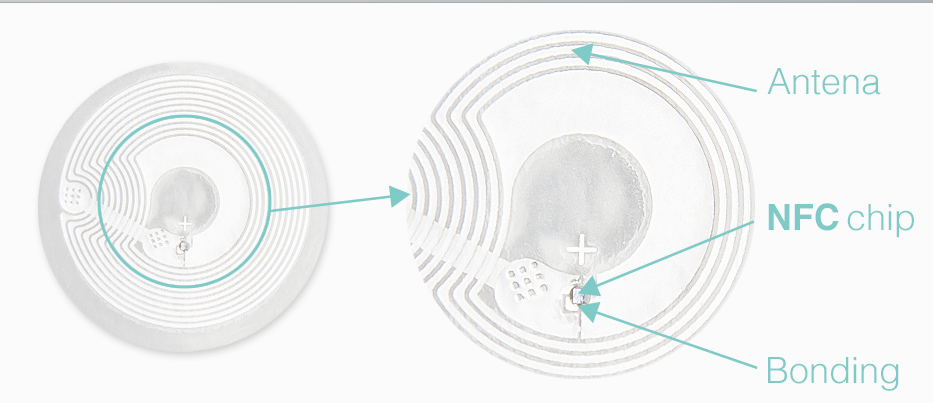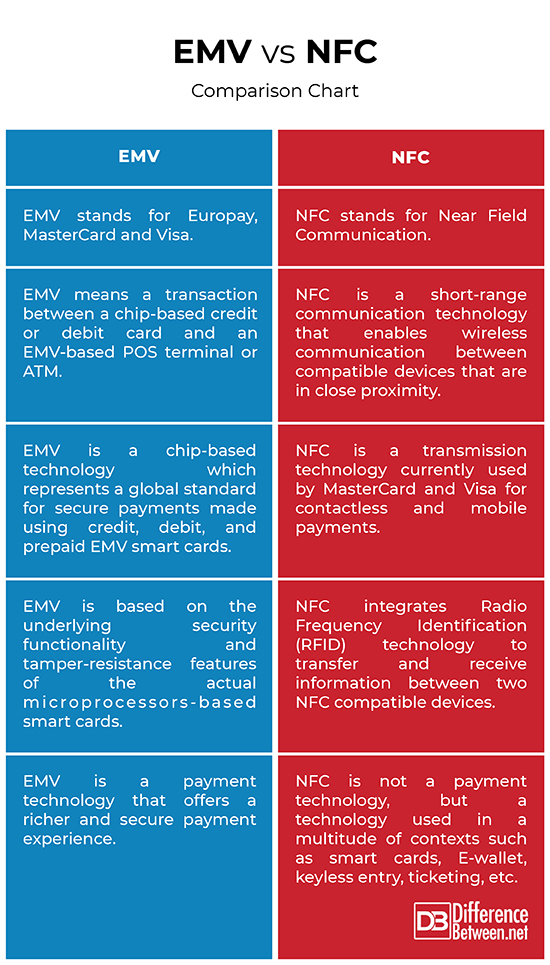Difference Between EMV and NFC
The last few decades witnessed some significant advancements in payment technologies. On one hand, the payment infrastructure was created, which consists of highly reliable computer networks connecting automatic teller machines (ATMs) and point of sale (POS) terminals with powerful mainframe computers of financial institutions. On the other hand, other instruments of financial services emerged. The most common are the magnetic stripe cards and ICCs, also known as chip cards. Due to some serious security concerns regarding the use of magnetic stripe cards which resulted in unacceptably high fraud levels, the banking industry realized that it needed a better alternative in the form of smart cards, and ultimately the EMV standard was developed.

What is EMV?
EMV stands for Europay, MasterCard, and Visa, and represents a global standard for secure payments made using credit, debit, and prepaid EMV smart cards at a merchant who has an EMV-compliant infrastructure. In the payments sector, the EMV serves as the global specification for the use of chip-based smart cards for credit and debit transactions worldwide. As the name suggests, the standard was devised by a joint industry working group of Europay, MasterCard, and Visa, and which provides global interoperable secure interface across chip-based credit and debit transactions. EMV offers a richer and secure payment experience being inspired from the underlying security functionality and tamper-resistance features of the actual smart card microprocessors. The EMV-compliant payment cards are basically chip-based cards that would require a personal identification (PIN) at POS terminals, which adds an extra layer of security.

What is NFC?
NFC short for “Near Field Communication,” is the transmission technology currently used by MasterCard and Visa for contactless and mobile payments. NFC is actually a technology that simplifies and secures how you interact with the people and things around you. It serves as a useful accessory for consumer transactions based on a set of standards that allow short-range wireless communication between compatible mobile devices such as smartphones, tablets and personal computers. It integrates Radio Frequency Identification (RFID) technology to transfer and receive information between two NFC compatible devices. However, NFC is not a payment technology; it is a complementary technology that helps with chip-based payment systems by determining how devices communicate with each other. NFC technology allows the incumbent POS networks to survive the shift to mobile payments in-store. NFC makes the pairing possible with just a single tap, providing a seamless and effortless contactless payment experience.
Difference between EMV and NFC
Meaning
– EMV is the global standard devised by a joint industry working group of Europay, MasterCard, and Visa, which provides global interoperable secure interface across chip-based credit and debit transactions. In practice, EMV means a transaction between a chip-based credit or debit card and an EMV-based POS terminal or ATM. NFC, short for Near Field Communication, is a transmission technology currently used by MasterCard and Visa for contactless and mobile payments. Both are companion technologies that complement each other in the payment ecosystem.
Technology
– EMV is a chip-based technology which represents a global standard for secure payments made using credit, debit, and prepaid EMV smart cards at a merchant who has an EMV-compliant infrastructure. EMV is based on the underlying security functionality and tamper-resistance features of the actual microprocessors-based smart cards. NFC, on the other hand, is not a payment technology; it is a useful accessory for consumer transactions based on a set of standards that allow short-range wireless communication between compatible mobile devices using RFID protocols.
Security
– The main aim of the EMV standard is to overcome the limitations of magnetic stripe card technology and, at the same time, to provide a more secure and reliable instrument for payment applications. EMV offers a richer and secure payment experience by providing protection against the use of counterfeit, stolen or lost cards. The account information stored on EMV cards is uniquely encrypted every time it is accessed. NFC devices use the same payment infrastructure as EMV card based transactions, so the transactions are pretty much secure because the application supplies the required security. The risk is negligible with NFC, but it still exists.
EMV vs. NFC: Comparison Chart

Summary
Well, EMV and NFC are not contradictory technologies; in fact, they are companion technologies. EMV is a payment technology that offers a richer and more secure payment experience by providing global standard for the use of chip-based smart cards for credit and debit transactions worldwide. The main aim of the EMV standard is to overcome the limitations of magnetic stripe card technology and, at the same time, to provide a more secure and reliable instrument for payment applications. NFC, on the other hand, is not exactly a payment technology, but is more likely used in a context of how the devices communicate with each other. NFC is a useful accessory for consumer transactions based on a set of standards that allow short-range wireless communication between compatible mobile devices.
- Difference Between Caucus and Primary - June 18, 2024
- Difference Between PPO and POS - May 30, 2024
- Difference Between RFID and NFC - May 28, 2024
Search DifferenceBetween.net :
 Email This Post
: If you like this article or our site. Please spread the word. Share it with your friends/family.
Email This Post
: If you like this article or our site. Please spread the word. Share it with your friends/family.
Leave a Response
References :
[0]Mayes, Keith and Konstantinos Markantonakis. Smart Cards, Tokens, Security and Applications. Berlin, Germany: Springer, 2007. Print
[1]Radu, Cristian. Implementing Electronic Card Payment Systems. Massachusetts, United States: Artech House, 2003. Print
[2]Atkins, Wendy. The Smart Card Report. Amsterdam, Netherlands: Elsevier, 2003. Print
[3]Haddad, Aneace. A New Way to Pay: Creating Competitive Advantage Through the EMV Smart Card Standard. England, United Kingdom: Gower Publishing Limited, 2005. Print
[4]Sabella, Robert R. NFC for Dummies. New Jersey, United States: John Wiley & Sons, 2016. Print
[5]Coskun, Vedat et al. Near Field Communication (NFC): From Theory to Practice. New Jersey, United States: John Wiley & Sons, 2011. Print
[6]Image credit: https://smartcardamerica.com/wp-content/uploads/2020/06/EMV-Chip-technology-LOCKup-1536x1024.jpg
[7]Image credit: https://smartcardamerica.com/wp-content/uploads/2020/06/EMV-Chip-technology-LOCKup-1536x1024.jpg

